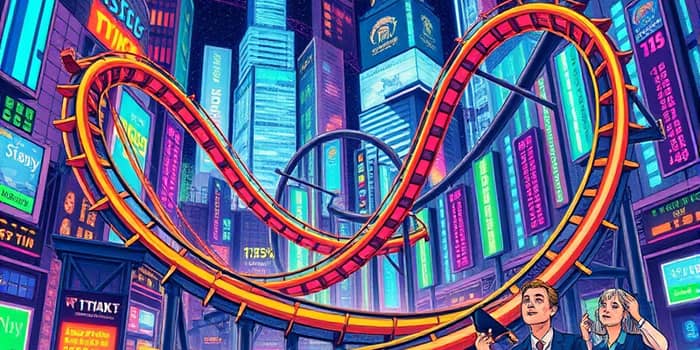
Across trading floors and online forums alike, the wild swings of meme stocks have captivated a generation of investors. What began as a playful experiment in collective action has morphed into a phenomenon that tests the limits of market stability and regulatory oversight. From the early days of GameStop’s meteoric rise to the latest 2025 resurgence, retail traders armed with smartphones have proven they can move markets on their own terms.
Amid this frenzy, policymakers and watchdogs are under pressure to adapt to a landscape where a single tweet or Reddit post can spark a buying frenzy. As volatility spikes and fortunes can change in seconds, the question on everyone’s mind is: how should regulators respond to protect both markets and the public?
At its core, a meme stock is one whose price is driven less by traditional business fundamentals and more by viral popularity on platforms like Reddit’s r/wallstreetbets, X (formerly Twitter), and TikTok. The term first gained traction in early 2021, when GameStop (GME) shares soared more than 100-fold in a matter of months due to a coordinated short squeeze by online communities. Suddenly, everyday investors challenged hedge funds and reshaped the narrative of market power.
Since then, the movement has spread to names like AMC Entertainment, MicroStrategy, and Mara Holdings, each experiencing dizzying peaks and gut-wrenching plunges. Enthusiasts celebrate the democratization of market access, while skeptics warn of a bubble fueled by hype rather than earnings or cash flow.
The anatomy of a meme stock rally often begins with a viral post or a high-profile influencer endorsement. Trading apps with one-click buying and instant social feeds amplify these signals, creating a feedback loop of excitement and demand. Within days, stocks can double or triple as retail orders flood in, sometimes triggering margin calls on short positions that further accelerate the ascent.
Yet as quickly as prices climb, they can collapse. The decentralized nature of retail networks means buyers can turn sellers overnight, leaving latecomers stranded. At the same time, institutional investors grapple with heightened market fragility, as they monitor not just earnings reports but also trending hashtags and forum chatter.
The backdrop for the 2025 meme stock resurgence was far from calm. A sudden U.S. stock market crash—triggered by escalating tariffs and policy uncertainty—wiped out over $6 trillion in equity value in just two days. The Nasdaq dropped 14% in a month, and the VIX volatility index surged to 45.3, its highest since the early pandemic.
In such an environment, high-beta assets like meme stocks become lightning rods for risk-seeking capital. Investors looking for outsized returns found comfort in the allure of coordinated buying power, even as broader markets reeled. The result has been a potent mix of systemic stress and retail-driven momentum, forcing all participants to confront new dynamics.
While stories of overnight millionaires abound, the other side of the coin is starkly different. Without the support of earnings, cash flow, or strong balance sheets, meme stocks can plummet with equal ferocity. Many investors learn too late that excitement can evaporate faster than it appears.
Emotional trading and groupthink often supplant rational analysis, blurring the line between strategic investing and pure entertainment. For novices, the consequences can be devastating.
Regulators have taken notice. In the U.S., the SEC and FINRA have issued warnings about heightened trading risks and launched probes into suspicious trading patterns. Canada’s Ontario Securities Commission has invoked its public interest powers to intervene when markets appear distorted, even without clear rule violations.
Yet critics argue responses have been reactive rather than proactive. During the peak of the GameStop saga, temporary trading restrictions and inquiries into app-based purchase bans highlighted the tension between preserving market integrity and respecting investor freedom.
The challenge lies in distinguishing between legitimate viral enthusiasm and orchestrated manipulation—an evolving legal gray area that may demand fresh legislation or clearer guidelines.
The meme stock phenomenon exemplifies a broader shift toward democratized market participation. Trading platforms have dismantled barriers, inviting millions into a realm once dominated by institutional money. Online communities foster identity and purpose, blending financial gain with social belonging.
This gamification of investing has both empowered and ensnared participants. While some champion the crowdsourced challenge to Wall Street’s gatekeepers, others warn of unintended consequences: volatility that can trigger system-wide stress, herd behavior that undermines price discovery, and a fleeting sense of unity that may leave individuals exposed.
As meme stocks continue to shape market narratives, both investors and regulators must adapt. For individuals, a disciplined approach—grounded in long-term investment strategies and sound risk management—remains essential. Understanding margin requirements, setting stop-loss orders, and conducting due diligence on fundamentals can help temper emotion-driven decisions.
Policymakers face the delicate task of encouraging innovation while safeguarding market stability. Options include clearer rules on social media promotion, stronger oversight of high-frequency trading, and educational initiatives to elevate financial literacy among retail participants.
Ultimately, the meme stock phenomenon underscores a powerful truth: markets are not static, and power can shift in unexpected ways. By striking a balance innovation and protection, stakeholders can harness the energy of retail engagement without sacrificing integrity. The road ahead may be bumpy, but with thoughtful collaboration, the next chapter of market evolution can be both inclusive and resilient.
References













